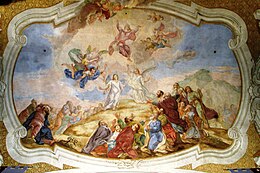|
Wer da gläubet und getauft wird, BWV 37
Wer da gläubet und getauft wird (He who believes and is baptised),[1] BWV 37,[a] is a cantata by Johann Sebastian Bach, a church cantata for the feast of the Ascension of Jesus. Bach composed it in Leipzig and first performed it on 18 May 1724. The work is Bach's first cantata composition for the feast of the Ascension. Surprisingly for a high feast day, it is modestly scored; only two oboes d'amore add to the sound of the regular strings and basso continuo, accompanying four vocal parts. An anonymous poet derived thoughts from the prescribed Gospel, even quoting a verse, but excluded the Ascension itself and concentrated on the Lutheran idea of justification by faith alone. The poet structured the six movements of the cantata in two parts, each concluded by a chorale. History and wordsBach composed the cantata in Leipzig for Ascension. The prescribed readings for the feast day were from the Acts of the Apostles, the prologue and Ascension (Acts 1:1–11), and from the Gospel of Mark, Jesus telling his disciples to preach and baptize, and his Ascension (Mark 16:14–20).[2] An unknown poet began with the quotation of verse 16 from the Gospel.[3] Werner Neumann suggests that Christian Weiss may be this anonymous poet.[4] Klaus Hofmann notes that the pattern of the text is the same as in Wo gehest du hin? BWV 166, and Wahrlich, wahrlich, ich sage euch, BWV 86, performed the two previous Sundays.[5] While the Gospel contains both the request to preach and baptise, and the ascension, the cantata text excludes the ascension and concentrates on the justification of the baptised Christian by faith.[2] The cantata is short, but nonetheless in two parts, each closed by a chorale, the fifth stanza of Philipp Nicolai's hymn "Wie schön leuchtet der Morgenstern" (1599) as movement 3 and for the closing chorale the fourth stanza of the hymn "Ich dank dir, lieber Herre" (c. 1535) by Johannes Kolrose.[2] Part I (movements 1 through 3) reflects the love of Jesus, with the chorale expressing thanks for it. Part II (movements 4 through 6) argues like a sermon, reminiscent of Paul's teaching in Romans 3:28, that good works alone are not enough for a blessed life if they are not founded in faith. The closing chorale is another song of thanks.[2] Bach first performed the cantata on 18 May 1724,[6] and again on 3 May 1731. It was his first composition for the feast of the Ascension.[7] Scoring and structureThe cantata in six movements is scored rather modestly: the four vocal soloists (soprano, alto, tenor and bass) and a four-part choir are accompanied only by two oboes d'amore, two violins, viola and basso continuo.[2][8] Bach's cantatas for the occasion in later years, Auf Christi Himmelfahrt allein, BWV 128, and Gott fähret auf mit Jauchzen, BWV 43, and his Ascension Oratorio use a more festive orchestra including horns or trumpets.[2]
MusicAlthough the text for the first movement is a quotation of Jesus, it is not given to the bass as the vox Christi but to the choir. John Eliot Gardiner notes that Bach treats it as a "statement by the faithful, as though to demonstrate that they had already absorbed its message to 'go into all the world, and preach the gospel to every creature".[7] The movement begins with an extended instrumental Sinfonia which introduces three melodic lines that occur simultaneously. The first motif is played by the oboes and later taken by the choir,[2] According to Gardiner, it suggests "steadfastness of faith".[7] The second motif in the violins is reminiscent of Luther's hymn "Dies sind die heiligen zehn Gebot" (These are the holy Ten Commandments), which opened two other cantatas. Gardiner describes it as "emollient and graceful, a halfway house between a minuet and a waltz, affirming a more serene side to faith."[7] The third motif is part of the hymn "Wie schön leuchtet der Morgenstern" and appears in the continuo. In two vocal sections, the voices are embedded in a repetition of the Sinfonia.[2] Movement 2 is an aria with a solo violin part missing, as the Neue Bach-Ausgabe reported.[2] In movement 3, the chorale appears in the form of a chorale concerto, an Italianate form that Johann Hermann Schein had used a century earlier.[5] The chorale melody is changed according to the meaning of the words; only the continuo accompanies two voices. The following recitative is accompanied by the strings. They appear also in the last aria, in which an oboe comes and goes, with interesting effects. The closing chorale is a four-part setting.[2] Recordings
Notes
References
Cited sourcesSources
|
||||||||||||||||||||||||||||||||||||||||||||||||||||||||||||||||||||||||||||||
